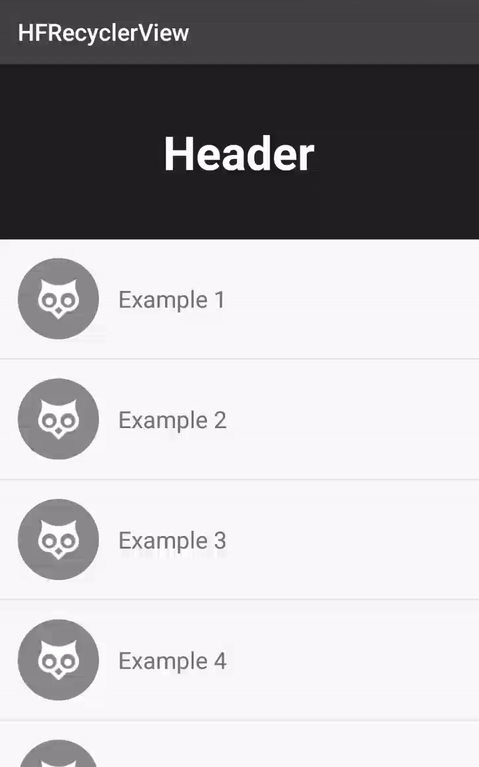RecyclerView header and footer
Maybe this question has been asked before, but I could not seem to find a precise answer or solution. I started using the RecyclerView, and I implemented it using the LinearLayoutManager. Now I want to add custom header and footer items, that differ from the rest of the items in my RecyclerView. The header and footer should not be sticky, I want them to scroll with the rest of the items. Can somebody point out some example how to do this or just share ideas. I will appreciate it very much. Thx
Solution 1:
in your adapter add this class:
private class VIEW_TYPES {
public static final int Header = 1;
public static final int Normal = 2;
public static final int Footer = 3;
}
then Override the following method like this:
@Override
public int getItemViewType(int position) {
if(items.get(position).isHeader)
return VIEW_TYPES.Header;
else if(items.get(position).isFooter)
return VIEW_TYPES.Footer;
else
return VIEW_TYPES.Normal;
}
Now in the onCreateViewHolder method inflate your layout based on the view type::
@Override
public ViewHolder onCreateViewHolder(ViewGroup viewGroup, int i) {
View rowView;
switch (i) {
case VIEW_TYPES.Normal:
rowView = LayoutInflater.from(viewGroup.getContext()).inflate(R.layout.normal, viewGroup, false);
break;
case VIEW_TYPES.Header:
rowView = LayoutInflater.from(viewGroup.getContext()).inflate(R.layout.header, viewGroup, false);
break;
case VIEW_TYPES.Footer:
rowView = LayoutInflater.from(viewGroup.getContext()).inflate(R.layout.footer, viewGroup, false);
break;
default:
rowView = LayoutInflater.from(viewGroup.getContext()).inflate(R.layout.normal, viewGroup, false);
break;
}
return new ViewHolder (rowView);
}
Now in the onBindViewHolder method bind your layout based on the view holder:
@Override
public void onBindViewHolder(@NonNull RecyclerView.ViewHolder viewHolder, int position) {
int viewType = getItemViewType(position);
switch(viewType) {
case VIEW_TYPES.Header: // handle row header
break;
case VIEW_TYPES.Footer: // handle row footer
break;
case VIEW_TYPES.Normal: // handle row item
break;
}
}
Hope this can help.
Solution 2:
This is very easy with ItemDecorations and without modifying any other code:
recyclerView.addItemDecoration(new HeaderDecoration(this,
recyclerView, R.layout.test_header));
Reserve some space for drawing, inflate the layout you want drawn and draw it in the reserved space.
The code for the Decoration:
public class HeaderDecoration extends RecyclerView.ItemDecoration {
private View mLayout;
public HeaderDecoration(final Context context, RecyclerView parent, @LayoutRes int resId) {
// inflate and measure the layout
mLayout = LayoutInflater.from(context).inflate(resId, parent, false);
mLayout.measure(View.MeasureSpec.makeMeasureSpec(0, View.MeasureSpec.UNSPECIFIED),
View.MeasureSpec.makeMeasureSpec(0, View.MeasureSpec.UNSPECIFIED));
}
@Override
public void onDraw(Canvas c, RecyclerView parent, RecyclerView.State state) {
super.onDraw(c, parent, state);
// layout basically just gets drawn on the reserved space on top of the first view
mLayout.layout(parent.getLeft(), 0, parent.getRight(), mLayout.getMeasuredHeight());
for (int i = 0; i < parent.getChildCount(); i++) {
View view = parent.getChildAt(i);
if (parent.getChildAdapterPosition(view) == 0) {
c.save();
final int height = mLayout.getMeasuredHeight();
final int top = view.getTop() - height;
c.translate(0, top);
mLayout.draw(c);
c.restore();
break;
}
}
}
@Override
public void getItemOffsets(Rect outRect, View view, RecyclerView parent, RecyclerView.State state) {
if (parent.getChildAdapterPosition(view) == 0) {
outRect.set(0, mLayout.getMeasuredHeight(), 0, 0);
} else {
outRect.setEmpty();
}
}
}
Solution 3:
You can use this GitHub] library to add a Header or Footer to your RecyclerView in the simplest way possible.
You need to add the HFRecyclerView library in your project or you can also grab it from Gradle:
compile 'com.mikhaellopez:hfrecyclerview:1.0.0'
This library is based on a work at @hister
This is a result in image:
